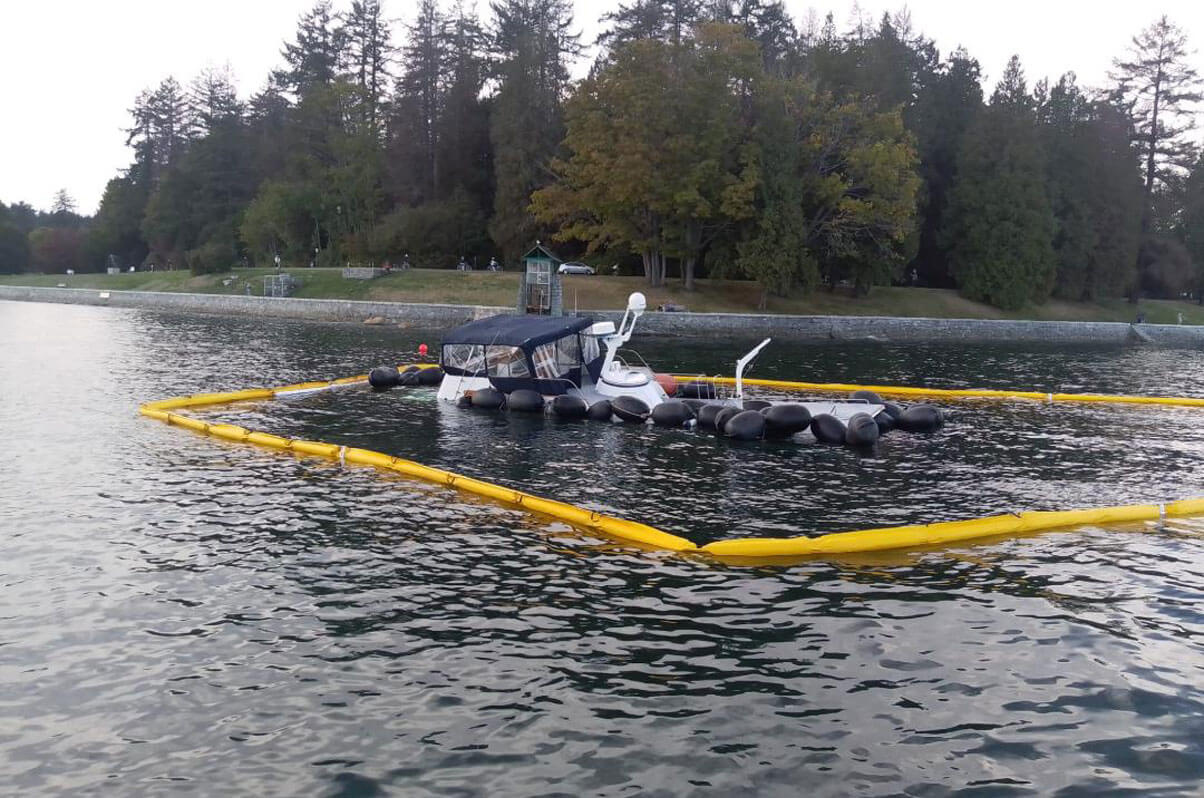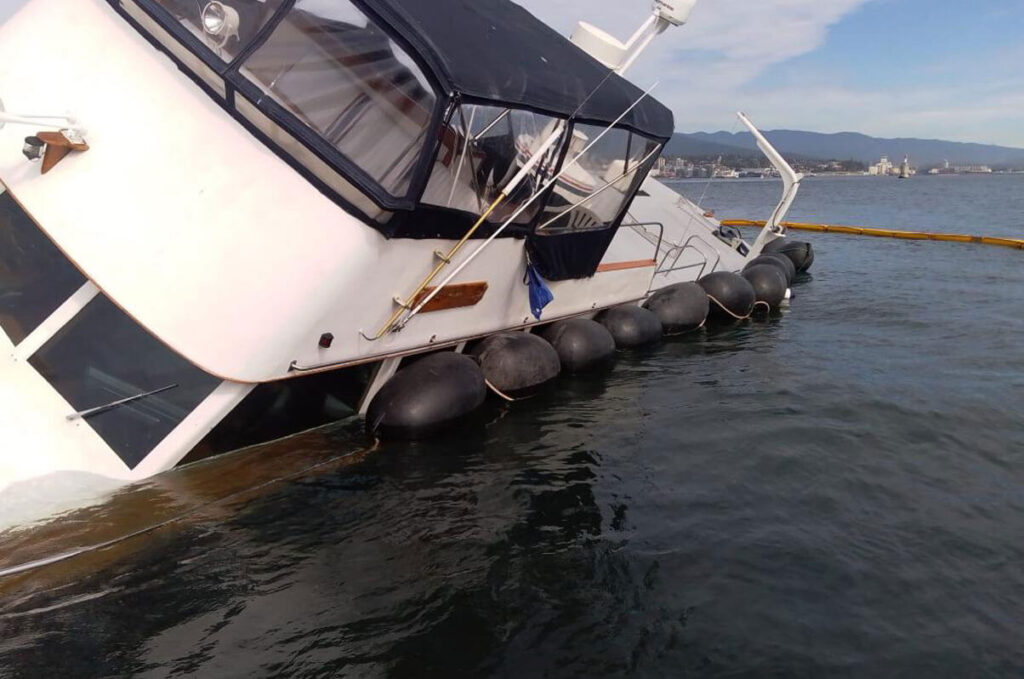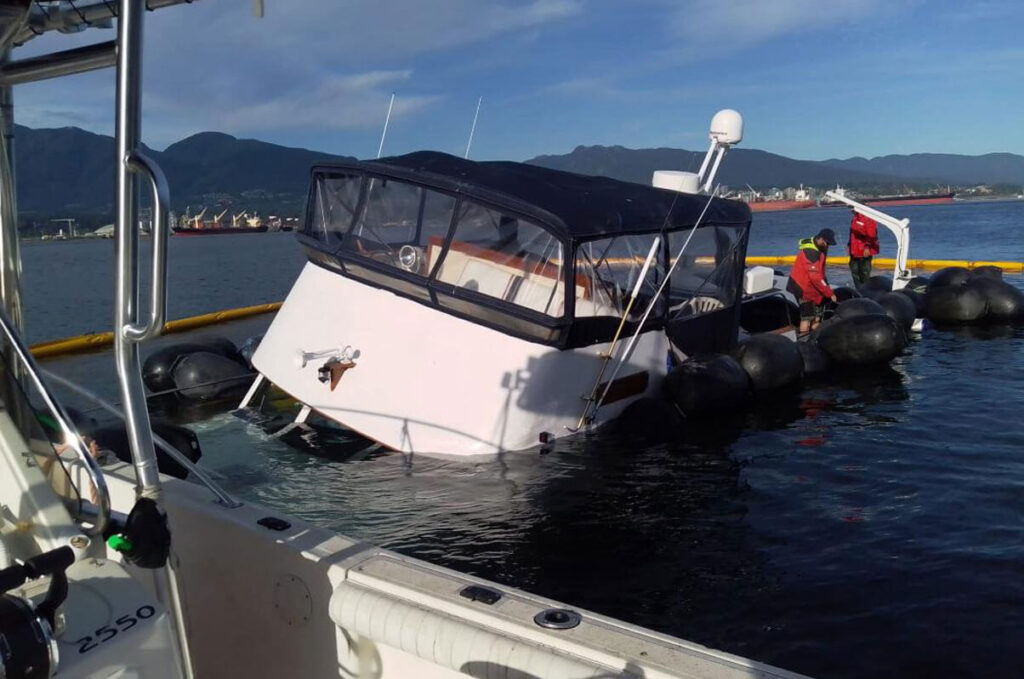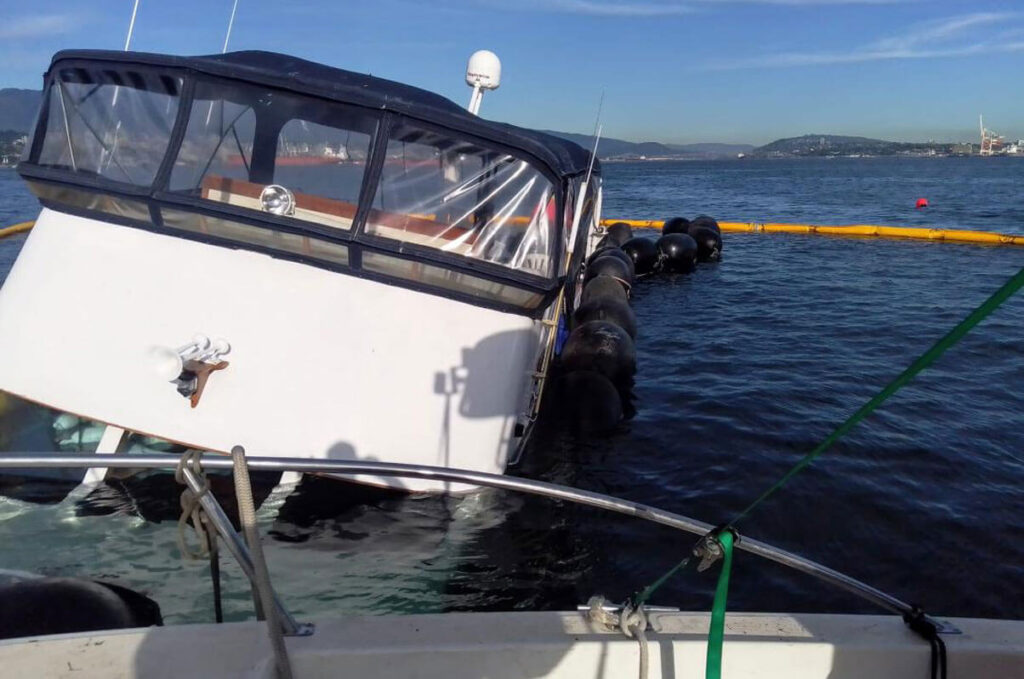
I have been working for C-Tow out of Deep Cove in North Vancouver, BC, since 2021. After several rescues, my most memorable was a call from an owner of a 1964 56-foot Monk motoryacht, explaining his boat was taking on water and was about to sink in Vancouver Harbour.
The owner explained his engine alarm sounded, but it didn’t indicate why. As I work alongside my father, who is also a C-Tow captain, we started troubleshooting the problem. He was located offshore of Stanley Park in downtown Vancouver. He detailed the seriousness of the situation and that time was of the essence. We quickly suggested that if he wanted to save his motoryacht, the best option would be to gently run it aground in the shallows. That’s exactly what he did.

The 56’ motoryacht secured with the oyster buoys.
We immediately hit the water with our gear – including 30 oyster buoys – and made the quick 8 nautical-mile (NM) run in our 26-foot Pursuit centre console. Realizing this was a dire situation, we called three local C-Tow Captains for assistance who met us on the scene.
After arriving, the Canadian Coast Guard was present and laid out a floating security barrier to contain fuel and oil from the vessel’s engines. With the motoryacht’s deep draft and the tide being out, it was keeled over on its port side – half in and half out of the water.

Part of the C-Tow team providing excellent support.
During this time, The Imperial, a commercial barge from Ocean Legacy Foundation operated by C-Tow Captain James Middleton, arrived as a support and logistics boat. Like all C-Tow Captains for any rescue, we carefully assessed the situation, explored options, and shared thoughts on effective strategies to get the vessel safely back to port. As a result, with the oncoming tide, we planned to get it level and keep it afloat as long as possible.
So, I entered the water to tie off a series of oyster buoys on its port side rail. We then cleaned the interior of debris, sealed any areas where water was intruding, and ran the pumps to get it more buoyant.

The morning call turned into an overnight rescue.
By the early evening, when the tide came in, the vessel levelled but the buoys weren’t as effective with the amount of oncoming water. So, we continued to run the pumps throughout the night.
Day 2 and Our Return to Port
It took us until the early morning to pump out an efficient amount of water to get it level. Since we previously contacted the Vancouver Pile Driving Ltd., a local marine construction company with a commercial barge and high-capacity crane, they arrived at 11 a.m. ready for the next move.
The end game throughout the day and evening was to lift the motoryacht with the crane and transport it to Lynnwood Marina and Boatyard, the closest marine facility to Stanley Park.
With a plan in place, harnessing the motoryacht was another challenge. Sitting in a pool of oil and fuel over the last 24 hours prevented a secure lift; it kept slipping off the sling. When it was finally secured, it was hoisted out of the water and transported through Vancouver Harbour, halfway to Lynwood.
After securing the oyster buoys on both sides of the motoryacht and the pumps running at full capacity, it was lowered back into the water and detached from the sling. We then had the daunting task of towing it to Lynwood before it took on water again. So, we stabilized the vessel and began a slow tow with the Imperial off its bow and our Pursuit off the stern while crews on both boats manned lines to keep it level.
Once at the marina, our Pursuit took over the tow. It wasn’t easy while cruising at a mere 1.5 knots but we arrived just as the motoryacht was halfway down in the water again.
Navigating through the confines of the marina to the lift was another nearly-impossible feat. The boat was full of water, extremely heavy, and the buoys were still employed. Marina staff crewed a few dinghies and gathered a team with boat hooks along the slips to steer it away from moored vessels and around tight corners. One bad turn and it would’ve keeled over completely.
We finally landed it in the lift without further damage and it was hoisted onto a set of blocks. Water just cascaded from its hull.
By this time, it was 11 p.m., more than 30 hours since we received the initial call. Working as a team with C-Tow captains Ritchie, Mark, and James – along with the efforts of the Vancouver Pile Driving Ltd. and The Canadian Coast Guard – is what it took to successfully prevent a bad situation from becoming much worse. It was discussing pump and buoy placements, managing the logistics, and determining approach angles that kept the motoryacht from completely sinking.
We later learned that the motoryacht’s bilge pump malfunctioned and backfired, forcing water in, instead of out. The owner made the right decision by contacting C-Tow. Our team of captains has the expertise, certified skills, and marine knowledge to safely manage a variety of vessels in distress.
Visit us online to become a member or contact us at (888) 419-2869 or info@c-tow.ca.
